Wage spending across Europe’s elite football leagues has never been higher – but the divide between clubs within each league tells a story of its own. Sportingpedia’s latest report compares the scale of player salaries investment in the top divisions of England, Spain, Germany, France, Italy, the Netherlands, and Portugal, shining a light on the game’s biggest financial powerhouses and its widest pay divides.
One of the report’s most curious revelations is that the Premier League stands unrivalled at the top, with English clubs committing a record €2.41 billion to player wages for the 2025/26 season – more than 65% higher than La Liga, the continent’s next-biggest spender. Another striking finding is that nineteen clubs across Europe are investing more than €100 million in annual salaries, with nearly half of them based in England.
But when it comes to the gap between the highest and lowest spenders within each league, the contrasts are even more flabbergasting. Ligue 1’s Paris Saint-Germain pays over 25 times more than Le Havre, while in Spain, Real Madrid’s salary bill is more than 12 times higher than Levante’s. By comparison, the Premier League is the most balanced at the top and bottom: Manchester City’s outlay is just four times that of Brentford – the narrowest disparity among Europe’s major leagues.
No club in Portugal or the Netherlands even comes close to matching the Premier League’s lowest spender, underlining the vast and persistent gulf in resources between Europe’s established giants and their continental peers.
Methodology: We compiled data from Capology.com, focusing on Europe’s top seven football leagues: the Premier League, La Liga, Serie A, Bundesliga, Ligue 1, Liga Portugal, and Eredivisie. The salary figures reflect each club’s “Annual Payroll – First Team Base Wages” for the 2025/26 season. The analysis compares total wage bills, individual club payrolls, and the ratio between the highest and lowest spenders within each league to highlight disparities in salary structures across Europe’s elite divisions.
Total and Average Club Wages in Europe’s Top 7 Leagues for 2025/26 Season
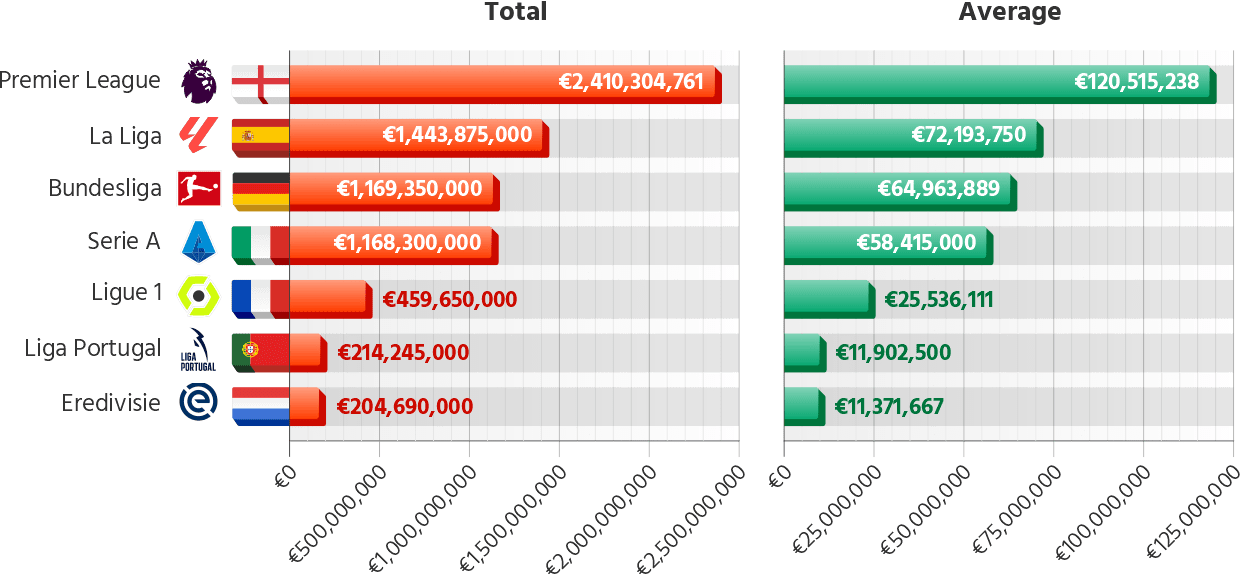

Data Source: Capology.com
Wage Gaps in Europe’s Top Leagues Stretch from 4x in England to 25x in France Between Clubs
The scale of wage spending in Europe’s top leagues is further emphasised when comparing each league’s biggest and smallest payers. In the Premier League, Manchester City leads with €255.3 million, accounting for over 10.5% of the league’s total wage bill – more than quadruple the amount of Brentford’s €62.5 million, the lowest in the competition. In Spain’s La Liga, Real Madrid’s wage bill stands at €305.4 million, representing an imposing 21.2% of the league’s total, while Levante, at the bottom, allocates just €25.1 million. Bayern Munich dominates the Bundesliga, paying €257.4 million in salaries, a remarkable 22% share of the league’s total, compared to Heidenheim’s €25.1 million.
A similar trend is evident in Serie A, where Inter spends €136.2 million – 11.7% of the league total – while Lecce, at the lower end, pays €19.6 million. In Ligue 1, PSG’s financial dominance is unparalleled: their €157.9 million wage bill is 34.4% of the league’s combined total and nearly 25 times that of Le Havre (€6.3 million). In Liga Portugal, Benfica’s €42.5 million accounts for nearly 20% of the league’s salaries, a figure more than 12 times higher than that of Alverca, the lowest spender at €3.4 million. In the Dutch Eredivisie, PSV leads with €35.1 million (17.1% of the league total), dwarfing Telstar’s €2.3 million.
These figures reveal that, in every league, one or two clubs carry a disproportionately large share of the financial burden. The gap is most pronounced in France, Spain, and Germany, where the top spenders – PSG, Real Madrid, and Bayern Munich – alone account for a fifth or more of all salaries paid in their respective divisions. This concentration of resources at the very top continues to widen the gulf between the leading clubs and their domestic competitors.
Premier League 2025/26: First Team Base Wages
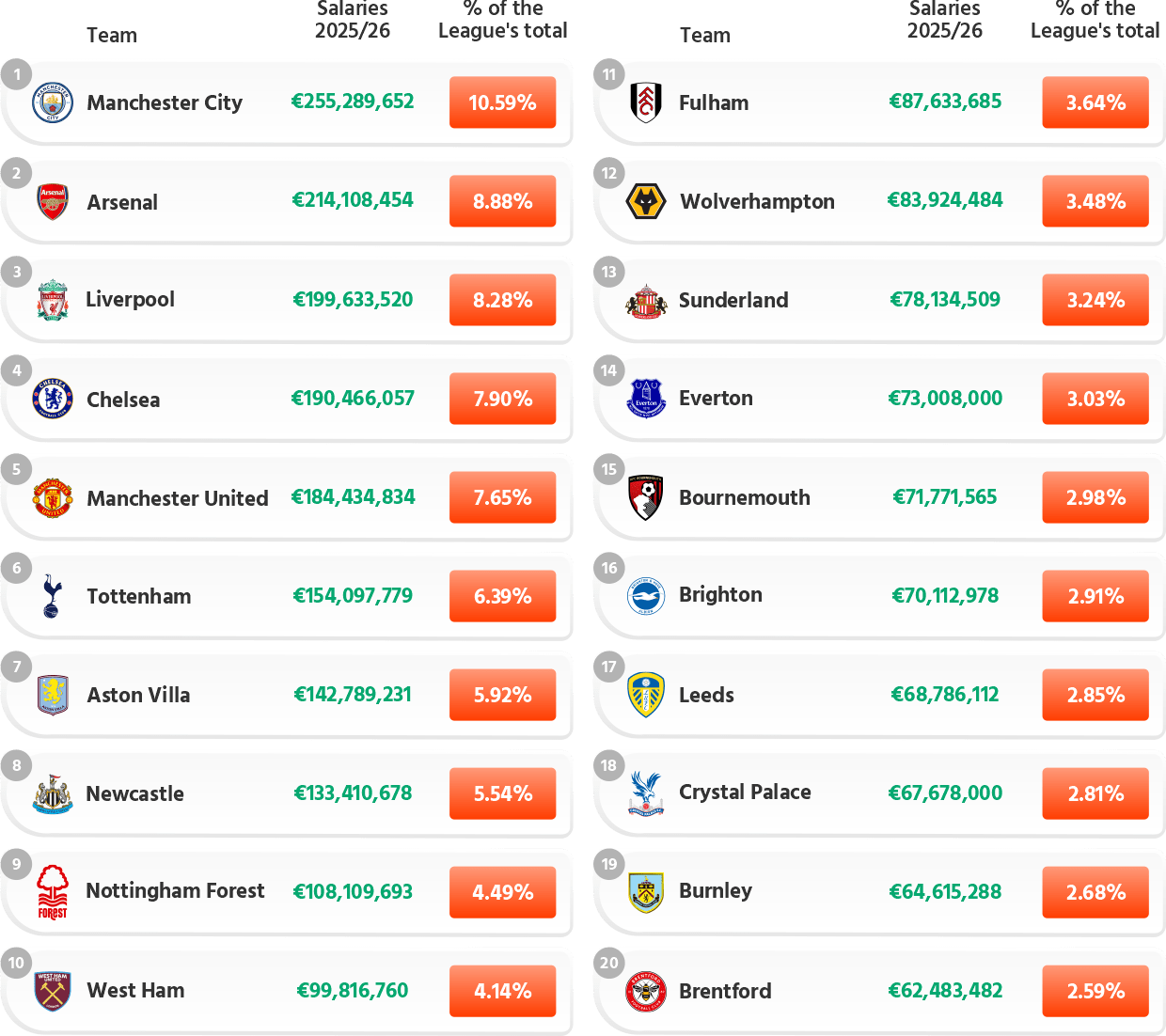

Data Source: Capology.com
No league in world football spends more on player wages than the Premier League, but within England’s top flight, the gulf between the top and bottom is staggering. Manchester City lead the way, committing an eye-watering €255.3 million in salaries for 2025/26 – more than 10.5% of the entire league’s wage bill. Arsenal, Liverpool, Chelsea, Manchester United, and Tottenham round out the traditional “big six,” each dedicating well over €150 million to player wages, and together accounting for nearly half of the division’s total payroll. Aston Villa and Newcastle are the only other sides exceeding the €130 million mark, a threshold the majority of Premier League clubs cannot reach. In stark contrast, Brentford spent just €62.5 million – barely a quarter of City’s outlay, and less than 2.6% of the league-wide total. The seven lowest-paying clubs combined still fall short of matching City’s wage bill. The figures lay bare the extraordinary financial imbalance within the Premier League, where a handful of clubs command resources dwarfing the rest, and the battle for talent is as unequal as the fight for silverware.
La Liga 2025/26: First Team Base Wages
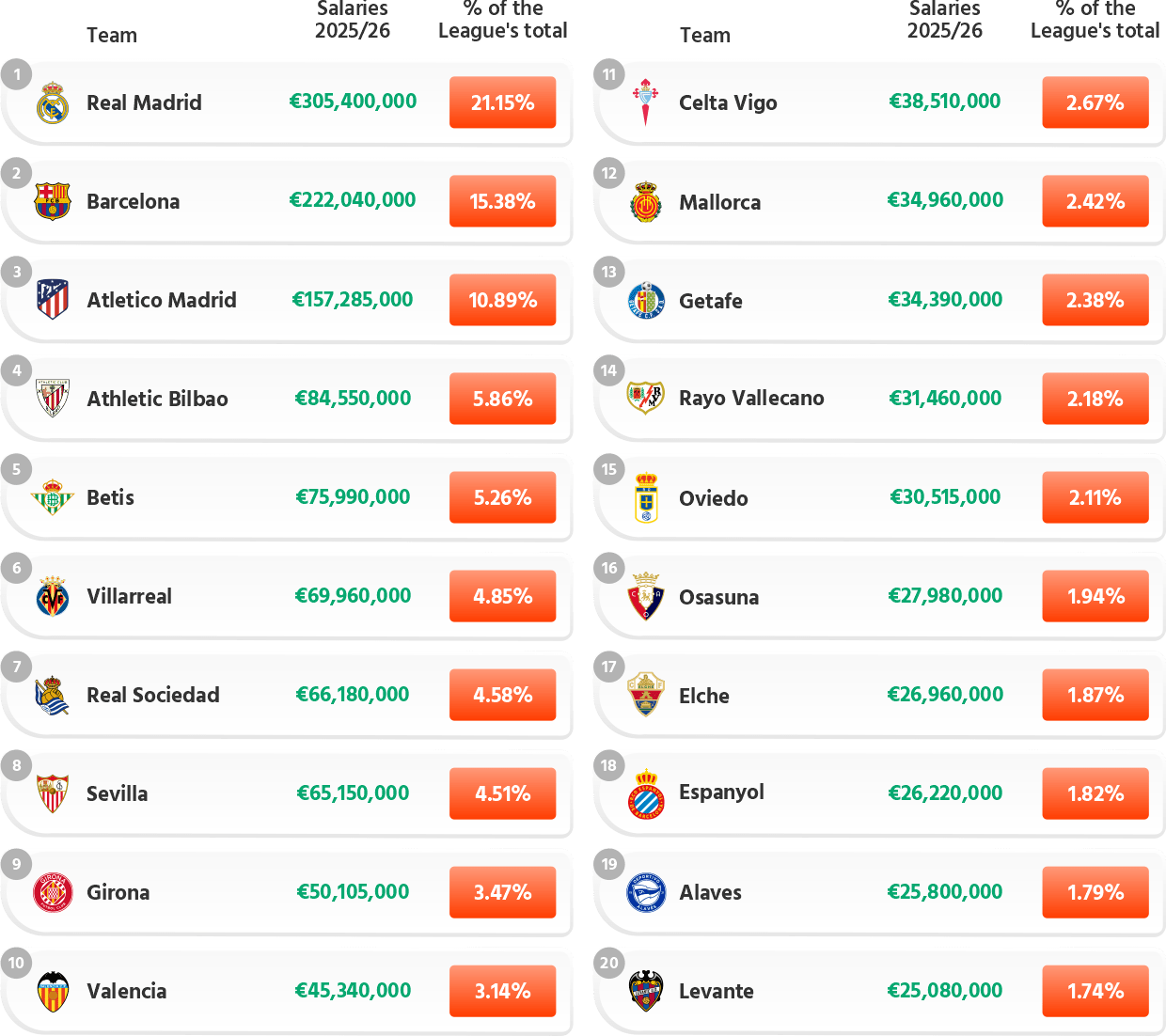

Data Source: Capology.com
Real Madrid are the undisputed paymasters of Spanish football, committing €305.4 million to first team base salaries for 2025/26 – more than 21% of the entire league’s wage bill and over €80 million clear of their historic rivals Barcelona, whose €222 million payroll still places them comfortably in second. Atletico Madrid rank third at €157.3 million, a figure that stands apart from the rest of the league but is less than half Real Madrid’s outlay.
Beyond the established giants, only Athletic Bilbao (€84.6 million) and Betis (€76 million) exceed the €70 million mark. Clubs such as Villarreal, Real Sociedad, and Sevilla operate in the €65-70 million range, underscoring a pronounced second tier. The drop-off from there is steep: Girona, Valencia, and Celta Vigo all spend less than €51 million on wages, while Mallorca, Getafe, and Rayo Vallecano sit below €35 million. At the very bottom, Oviedo, Osasuna, Elche, Espanyol, Alaves, and Levante each allocate less than €31 million to first-team salaries – barely a tenth of what Madrid pay.
The combined wage bills of the eight lowest-spending clubs do not match Real Madrid’s single payroll. The financial gulf underlines just how dominant the giants of Spanish football remain, both in the transfer market and on the pitch, making La Liga a league of sharp contrasts where the superclubs’ financial firepower towers above the competition.
Serie A 2025/26: First Team Base Wages
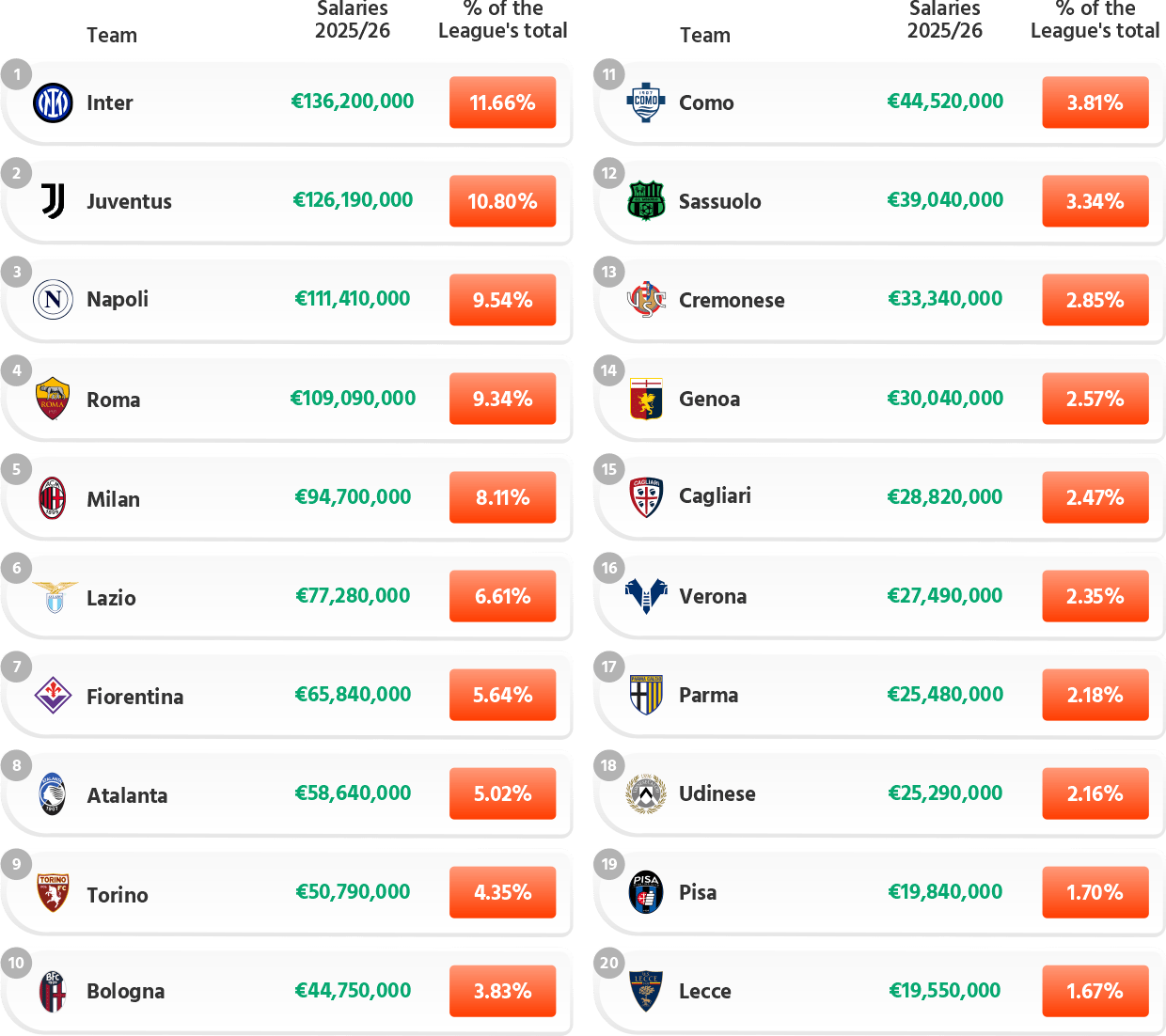

Data Source: Capology.com
Inter top Serie A’s wage table for 2025/26, committing €136.2 million to salaries – more than any other club in Italy and accounting for 11.7% of the entire league’s payroll. Their nearest rivals, Juventus and Napoli, follow with €126.2 million and €111.4 million respectively, with Roma not far behind on €109.1 million. Collectively, the five biggest spenders (Inter, Juventus, Napoli, Roma, Milan) are responsible for €577.6 million – just under half (49.4%) of all salaries paid out in Serie A.
At the other end of the scale, Lecce and Pisa are the league’s lowest spenders, allocating €19.6 million and €19.8 million respectively, with Udinese and Parma just above the €25 million mark. The gap between Inter and the lowest spender, Lecce, stands at €116.6 million – a financial gulf that mirrors the on-field disparity in resources. The wage bill of Inter alone is more than the combined salaries of the six lowest-spending clubs in Serie A, underlining the sharp divide between Italy’s elite and its strugglers.
Bundesliga 2025/26: First Team Base Wages
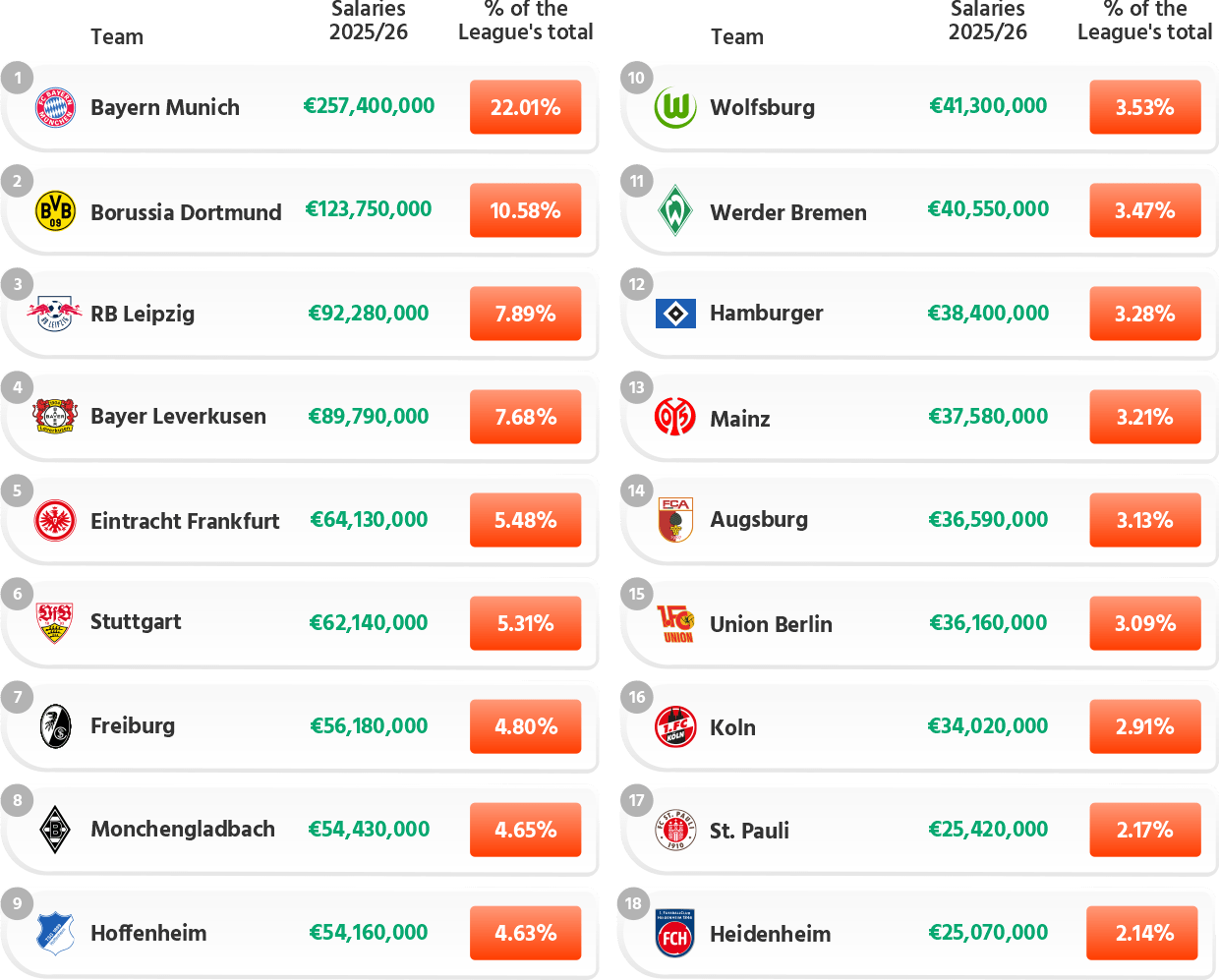

Data Source: Capology.com
Bayern Munich are the Bundesliga’s highest wage payers by a considerable margin, with a salary bill of €257.4 million – 22% of the league’s total spend. Their outlay is more than double that of Borussia Dortmund, who are next on the list with €123.8 million, and comfortably ahead of RB Leipzig (€92.3 million) and Bayer Leverkusen (€89.8 million). The combined salaries of the top five spenders (Bayern, Dortmund, Leipzig, Leverkusen, Frankfurt) amount to €627.4 million, covering more than half (53.7%) of all wages paid in the division.
At the other end of the spectrum, St Pauli and Heidenheim have the lowest salary commitments in the Bundesliga, each spending just over €25 million – roughly a tenth of Bayern’s outlay. The difference between Bayern Munich and the lowest spender, Heidenheim, is an extraordinary €232.3 million. This means Bayern’s wage bill is greater than the combined total of the eight lowest-spending clubs in the Bundesliga, underlining the extreme financial gap between the German champions and much of the rest of the league.
Ligue 1: 2025/26: First Team Base Wages
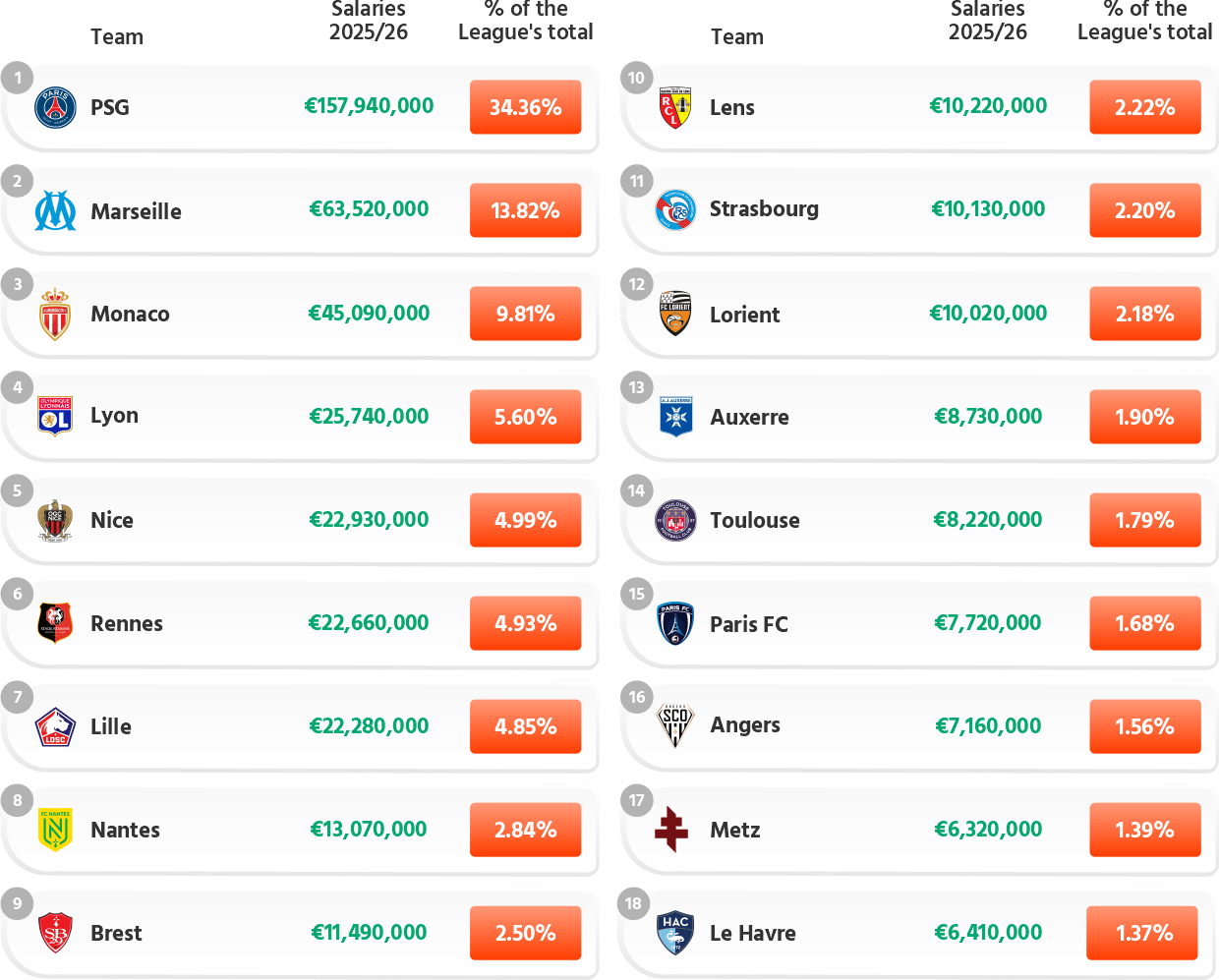

Data Source: Capology.com
Paris Saint-Germain are the dominant financial force in Ligue 1, with a wage bill of €157.94 million for the 2025/26 season – an amount that represents 34.4% of the entire league total. The gulf between PSG and their nearest competitors is striking: Marseille, the second-highest spenders, pay just €63.52 million, less than half of PSG’s outlay, while Monaco follow in third at €45.09 million. The three biggest spenders together account for 58% of all salaries paid in Ligue 1, reflecting an extraordinary concentration of resources at the very top.
At the opposite end of the table, Le Havre and Metz pay the lowest salaries in the division, with annual wage bills of just €6.32 million and €6.41 million respectively. This means that PSG commit nearly 25 times more to player wages than the league’s smallest spenders, with the gap between the top and bottom amounting to a staggering €151.62 million. Such disparities highlight how Ligue 1 remains one of Europe’s most polarised top flights, with financial power heavily concentrated in Paris and only a handful of clubs capable of approaching that level of investment.
Liga Portugal: 2025/26: First Team Base Wages
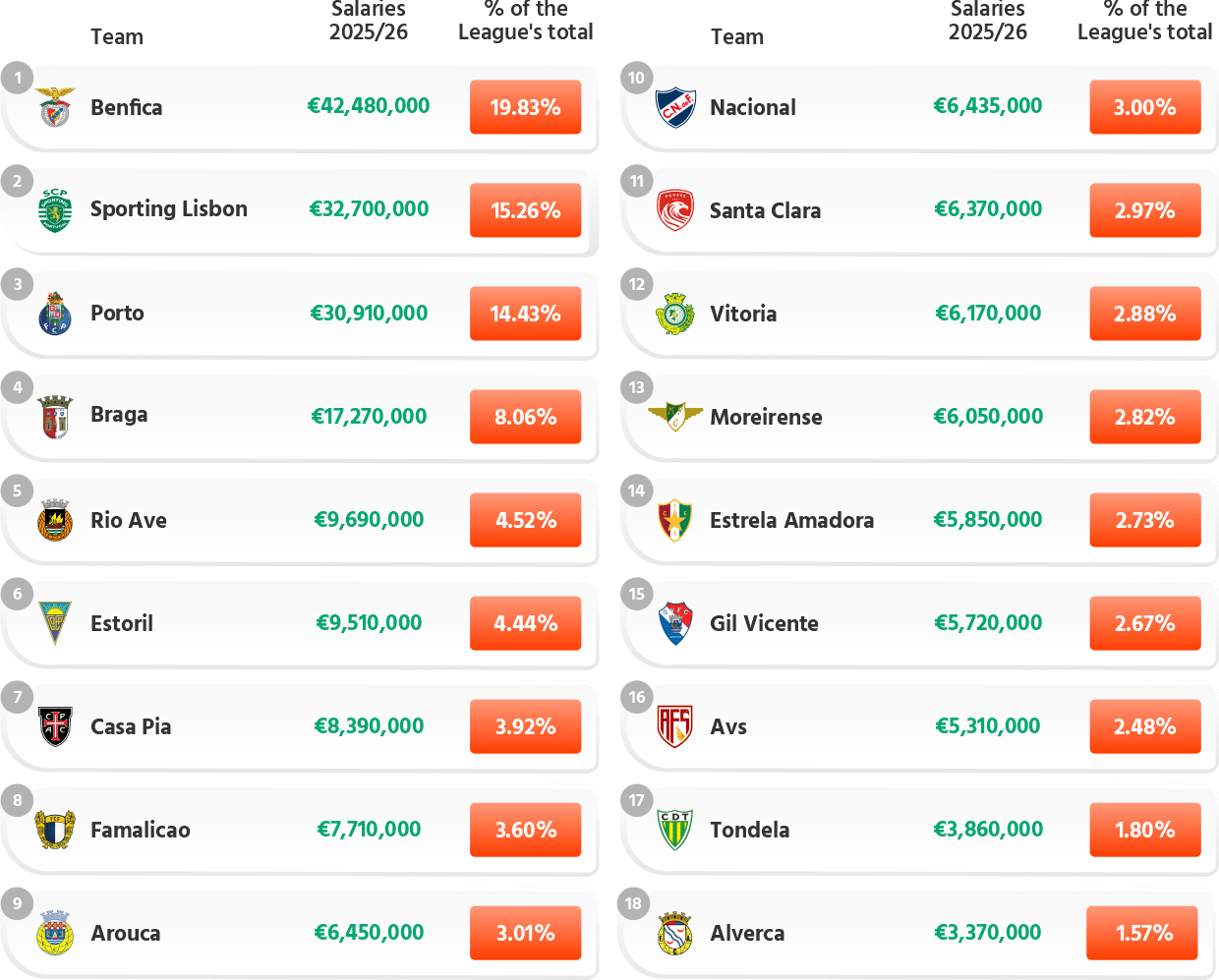

Data Source: Capology.com
Benfica top the wage rankings in Liga Portugal, committing €42.48 million to player salaries in 2025/26 – an amount that accounts for nearly 20% of the entire league’s outlay. Their nearest rivals, Sporting Lisbon and Porto, follow with wage bills of €32.70 million and €30.91 million, respectively. Together, the three traditional giants are responsible for almost half of all salary spending in the league, with a combined share of 49.5%. Braga, with €17.27 million in wages, are the only other side to surpass €10 million, underlining the steep drop-off after the top three.
At the opposite end, Alverca and Tondela pay the lowest salaries in the division, with annual wage bills of just €3.37 million and €3.86 million. This means Benfica spend over twelve times more on salaries than Alverca, with the gap between the highest and lowest standing at €39.11 million. The data highlights just how pronounced the financial divide is in Portugal’s top flight, with the top three clubs maintaining a huge advantage over the rest of the competition.
Eredivisie 2025/26: First Team Base Wages
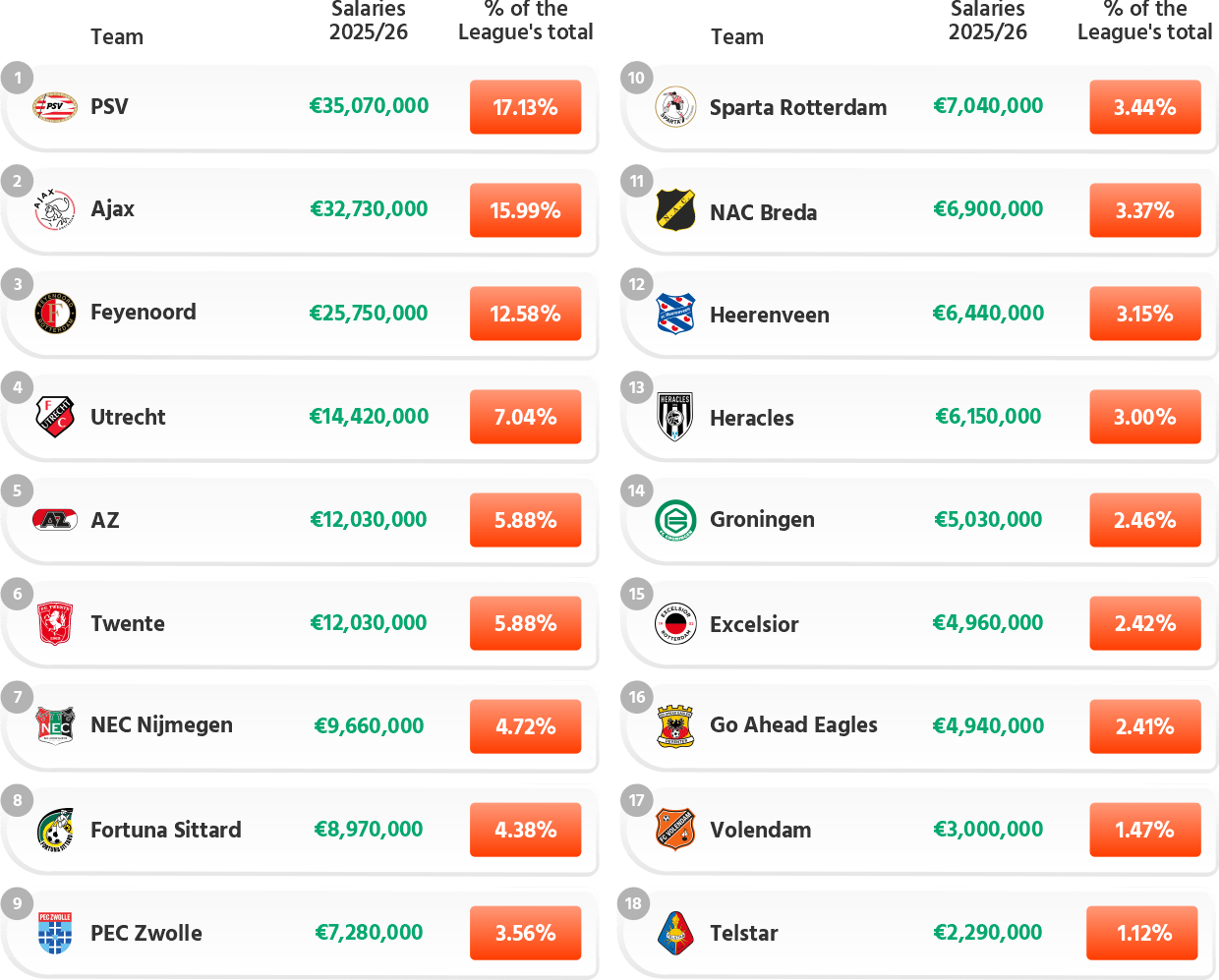

Data Source: Capology.com
PSV lead the Eredivisie in player salary spending, allocating €35.07 million in 2025/26 – a figure that amounts to over 17% of the league’s total wage bill. Ajax are close behind, with €32.73 million (16%), followed by Feyenoord on €25.75 million (13%). Collectively, these three clubs are responsible for nearly 46% of all salaries paid in the Dutch top flight, underlining their financial dominance.
Beyond the big three, Utrecht (€14.42 million), AZ and Twente (each €12.03 million) are the only other clubs spending over €10 million on wages. At the bottom of the scale, Telstar pay just €2.29 million – a figure more than fifteen times lower than PSV’s outlay, creating a gap of €32.78 million between the league’s highest and lowest spenders. The numbers reinforce the clear financial hierarchy in Dutch football, with the traditional giants and a handful of challengers well ahead of the rest.